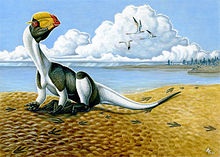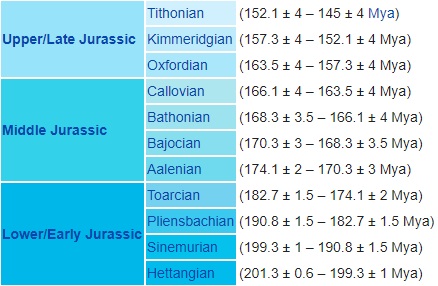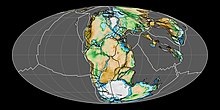|
|
| |
|
|
| |
|
|
|
|
| |
 |
| Depiction of Early
Jurassic environment preserved at the St. George
Dinosaur Discovery Site at Johnson Farm, with
Dilophosaurus wetherilli in bird-like resting
pose. |
Jurassic
The Jurassic (/dʒʊˈræs.sɪk/ juu-RASS-ik) is a geologic
period and system that spanned 56 million years from the
end of the Triassic Period 201.3 million years ago (Mya)
to the beginning of the Cretaceous Period 145 Mya. The
Jurassic constitutes the middle period of the Mesozoic
Era. The Jurassic is named after the Jura Mountains in
the European Alps, where limestone strata from the
period were first identified.
The start of the period was marked by the major
Triassic–Jurassic extinction event. Two other extinction
events occurred during the period: the
Pliensbachian-Toarcian extinction in the Early Jurassic,
and the end Jurassic transition, which is disputed in
its impact.
The Jurassic period is divided into three epochs: Early,
Middle, and Late. Similarly, in stratigraphy, the
Jurassic is divided into the Lower Jurassic, Middle
Jurassic, and Upper Jurassic series of rock formations.
By the beginning of the Jurassic, the supercontinent
Pangaea had begun rifting into two landmasses: Laurasia
to the north, and Gondwana to the south. This created
more coastlines and shifted the continental climate from
dry to humid, and many of the arid deserts of the
Triassic were replaced by lush rainforests.
On land, the fauna transitioned from the Triassic fauna,
dominated by both dinosauromorph and pseudosuchian
archosaurs, to one dominated by dinosaurs alone. The
first birds also appeared during the Jurassic, having
evolved from a branch of theropod dinosaurs. Other major
events include the appearance of the earliest lizards,
and the evolution of therian mammals. Crocodilians made
the transition from a terrestrial to an aquatic mode of
life. The oceans were inhabited by marine reptiles such
as ichthyosaurs and plesiosaurs, while pterosaurs were
the dominant flying vertebrates.
Etymology and history
The chronostratigraphic term "Jurassic" is directly
linked to the Jura Mountains, a mountain range mainly
following the course of the France–Switzerland border.
The name "Jura" is derived from the Celtic root *jor via
Gaulish *iuris "wooded mountain", which, borrowed into
Latin as a place name, evolved into Juria and finally
Jura. During a tour of the region in 1795, Alexander von
Humboldt recognized the mainly limestone dominated
mountain range of the Jura Mountains as a separate
formation that had not been included in the established
stratigraphic system defined by Abraham Gottlob Werner,
and he named it "Jura-Kalkstein" ('Jura limestone') in
1799.
Thirty years later, in 1829, the French naturalist
Alexandre Brongniart published a survey on the different
terrains that constitute the crust of the Earth. In this
book, Brongniart referred to the terrains of the Jura
Mountains as terrains jurassiques, thus coining and
publishing the term for the first time. The German
geologist Leopold von Buch in 1839 established the
three-fold division of the Jurassic, originally named
from oldest to youngest, the Black Jurassic, Brown
Jurassic and White Jurassic. The term "Lias" had
previously been used equivalently for strata of
equivalent age to the Black Jurassic in England by
Conybeare and Phillips in 1822. French palaeontologist
Alcide d'Orbigny in papers between 1842 and 1852 would
divide the Jurassic into ten stages “étages” based on
ammonite and other fossil assemblages in England and
France, of which seven are still used, though none
retain the original definition. German geologist and
palaeontologist Friedrich August von Quenstedt in 1858
would divide the three series of von Buch in the Swabian
Jura into six subdivisions defined by ammonites and
other fossils. German palaeontologist Albert Oppel in
studies between 1856 and 1858 altered d'Orbigny's
original scheme and further subdivided the stages into
biostratigraphic zones, based primarily on ammonites.
Most of the modern stages of the Jurassic were
formalized at the "Colloque du Jurassique á Luxembourg"
in 1962. |
|
 |
| The epochs and ages
of the Jurassic. |
Geology
The Jurassic period is divided into three epochs: Early,
Middle, and Late. Similarly, in stratigraphy, the
Jurassic is divided into the Lower Jurassic, Middle
Jurassic, and Upper Jurassic series of rock formations,
also known in Europe as Lias, Dogger and Malm. The three
epochs are subdivided into shorter spans of time called
ages. The ages of the Jurassic from youngest to oldest
are shown in the graphic.
Stratigraphy
Jurassic stratigraphy is primarily based around of the
use of ammonites as index fossils, with the First
Appearance Datum of specific ammonite taxa being used to
mark the beginnings of stages, and well as smaller
timespans within stages, referred to as "Ammonite
Zones", these in turn are also sometimes subdivided
further into subzones. Global stratigraphy is based on
standard European ammonite zones, with other regions
being calibrated to the European successions.
Mineral and hydrocarbon
deposits
The Kimmeridge Clay and equivalents are the major source
rock for the North Sea oil. The Arabian Intrashelf
Basin, deposited from the late Middle to Upper Jurassic,
is the setting of the world's largest oil reserves,
including the Ghawar Field, the world largest oil field.
The Jurassic aged Sargelu and Naokelekan Formations are
major source rocks for oil in Iraq. Over 1500 gigatons
of Jurassic coal reserves are found in North-West China,
primarily in the Turpan-Hami Basin and the Ordos Basin.
Impact craters
Major impact craters include the Morokweng crater, a 70
km diameter crater buried beneath the Kalahari desert in
northern South Africa. The impact is dated to the
Jurassic-Cretaceous boundary, around 145 Ma. The
Morokweng crater has been suggested to have had a role
in the turnover at the Jurassic-Cretaceous transition.
Another major impact crater is the Puchezh-Katunki
crater, 40-80 kilometres in diameter, buried beneath
Nizhny Novgorod Oblast, Russia. The impact has been
dated to the Sinemurian, around 192-196 Mya. |
|
 |
| Pangaea at the start
of Jurassic. |
Paleogeography
and tectonics
During the early Jurassic period, the supercontinent
Pangaea broke up into the northern supercontinent
Laurasia and the southern supercontinent Gondwana; the
Gulf of Mexico opened in the new rift between North
America and what is now Mexico's Yucatán Peninsula. The
Jurassic North Atlantic Ocean was relatively narrow,
while the South Atlantic did not open until the
following Cretaceous period. The continents were
surrounded by Panthalassa, with the Tethys Ocean between
Gondwana and Asia. At the end of the Triassic, there was
a marine transgression in Europe, flooding most parts of
central and western Europe transforming it into an
archipelago of islands surrounded by shallow seas. |
 |
| The breakup of
Gondwanaland took place during the Late
Jurassic, the Indian Ocean opened up as a
result. |
The Boreal Ocean was connected to the
western Tethys by the "Viking corridor", a several hundred
kilometer wide passage between the Baltic Shield and
Greenland. Madagascar and Antarctica began to rift away from
Africa during Early Jurassic, beginning the fragmentation of
Gondwana. At the beginning of the Jurassic, North and South
America remained connected, but by the beginning of the Late
Jurassic had rifted apart, forming the Caribbean Seaway,
connecting the western Tethys with eastern Panthalassa.
During the Early Jurassic, around 190 million years ago, the
Pacific Plate originated at the triple junction of the
Farallon, Phoenix, and Izanagi plates, the three main
oceanic plates of Panthalassa. The previously stable triple
junction had converted to an unstable arrangement surrounded
on all sides by transform faults, due to a kink in one of
the plate boundaries, resulting in the formation of the
Pacific Plate at the centre of the junction, which began to
expand. During the Middle to early Late Jurassic, the
Sundance Seaway, a shallow epicontinental sea would cover
much of northwest North America.
Climate
The climate of Jurassic was generally warmer than at
present, by around 5 °C to 10 °C. Atmospheric carbon dioxide
levels were likely four times higher than present. Forests
likely grew near the poles, and experienced warm summers and
cold, sometimes snowy winters, and there were unlikely to
have been ice sheets given the high summer temperatures,
though mountain glaciers may have existed. The ocean depths
were likely 8 °C warmer than present, and reefs grew 10° of
latitude further north and south. The Intertropical
Convergence Zone likely existed over the oceans, resulting
in large areas of desert in the lower latitudes. |
|
 |
| Terrestrial
environment of the Toarcian of Łęczna (Ciechocinek
Formation, Lublin, Poland), based on the
Bogdanka Coal Mine Flora. Dinosaurs are based on
material found on various locations of the
formation. |
Flora
End-Triassic extinction
The preceding end-Triassic extinction would result in
the decline of Peltaspermaceae seed ferns, with
Lepidopteris persisting into the Early Jurassic in
Patagonia. At the Triassic-Jurassic boundary in
Greenland, the sporomorph diversity suggests a complete
floral turnover. An analysis of macrofossil floral
communities in Europe suggests no extinction over the
Triassic-Jurassic boundary, and that changes were mainly
due to local ecological succession. Dicroidium, a seed
fern that was a dominant part of Gondwanan floral
communities during the Triassic, would decline at the
T-J, boundary, surviving as a relict in Antarctica into
the Sinemurian.
Fauna
Aquatic and marine
During the Jurassic period, the primary vertebrates
living in the sea were fish and marine reptiles. The
latter include ichthyosaurs, which were at the peak of
their diversity, plesiosaurs, including pliosaurs, and
marine thalattosuchian crocodyliformes of the families
Teleosauridae, Machimosauridae and Metriorhynchidae.
Calcareous sabellids (Glomerula) appeared in the Early
Jurassic. The Jurassic also had diverse encrusting and
boring (sclerobiont) communities, and it saw a
significant rise in the bioerosion of carbonate shells
and hardgrounds. Especially common is the ichnogenus
(trace fossil) Gastrochaenolites. During the Jurassic
period, about four or five of the twelve clades of
planktonic organisms that exist in the fossil record
either experienced a massive evolutionary radiation or
appeared for the first time. |
|
|
 Kiddle: Jurassic Kiddle: Jurassic
Wikipedia: Jurassic |
|
|
|
|
|
|
|
|
|
|
|
|
|
|
|
|
Search Fun Easy English |
|
|
|
|
|
|
|
|
|
|
|
|
|
|
|
About
Contact
Copyright
Resources
Site Map |